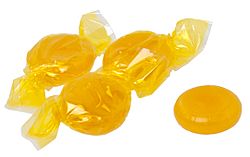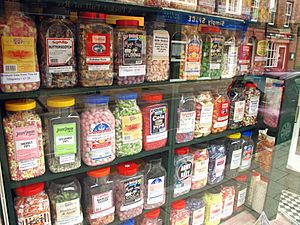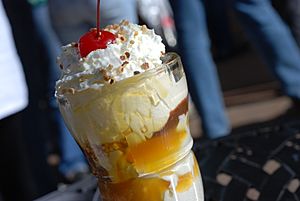Butterscotch facts for kids

Butterscotch sweets
|
|
| Type | Confectionery |
|---|---|
| Place of origin | England |
| Region or state | Doncaster, Yorkshire |
| Main ingredients | Brown sugar, butter |
Butterscotch is a yummy type of sweet candy. It is mostly made from brown sugar and butter. Some recipes also add things like corn syrup, cream, vanilla, and salt.
Butterscotch is a bit like toffee. But the sugar is cooked to a different stage. This makes butterscotch a little softer than toffee.
A company called Parkinson's in Doncaster, England, is often said to have invented butterscotch. They made these sweets and sold them in tins. These tins became very famous! In 1851, Queen Victoria even received a tin when she visited Doncaster.
The word "butterscotch" can also mean the flavor of brown sugar and butter together. You might taste this flavor in things like butterscotch pudding, even if it's not the candy itself.
Contents
What Does "Butterscotch" Mean?
Food experts have a few ideas about where the name "butterscotch" came from. But no one is completely sure!
One idea is that "scotch" means "to cut" or "to score." This is because the candy needs to be cut into pieces before it gets too hard. Another thought is that it might be linked to Scotland. The word "scotch" can also mean something from Scotland.
Some people think "scotch" might come from the word "scorch." This is because the sugar is cooked at a high heat. In 1855, a book about Yorkshire words said butterscotch was a "treacle ball with an amalgamation of butter in it."
The History of Butterscotch

Early stories about butterscotch connect it to Doncaster in Yorkshire, England. In 1848, a newspaper called the Liverpool Mercury shared a recipe for "Doncaster butterscotch." It said to boil one pound of butter, one pound of sugar, and a quarter pound of treacle together.
By 1851, Doncaster butterscotch was being sold by companies like S. Parkinson & Sons. They even used the Doncaster Church as their special trademark. It was called "Royal Doncaster Butterscotch" or "The Queen's Sweetmeat." People also said it was good for your chest in winter!
Parkinson's Butterscotch became very popular with the royal family. It was given to Princess Elizabeth (who later became Queen) in 1948. And it was given to Anne, Princess Royal in 2007. In the late 1800s and early 1900s, this British sweet also became popular in the United States.
Different Butterscotch Products

Butterscotch is often used as a flavor for many different foods. You can find it in dessert sauces, puddings, and biscuits (which are like cookies).
You can even buy "butterscotch chips." These are like chocolate chips but have a butterscotch flavor. They are great for baking! There are also hard candies called "butterscotch disks" that have an artificial butterscotch flavor. You can even find butterscotch-flavored liqueur.
Some companies, like Champion and Reeves in Shropshire, still make traditional butterscotch. They use British butter and cream.
Butterscotch Sauce
Butterscotch sauce is a delicious topping. It is made by cooking brown sugar with butter and cream. This sauce is often used on sundaes and other desserts.
See also
 In Spanish: Butterscotch para niños
In Spanish: Butterscotch para niños

